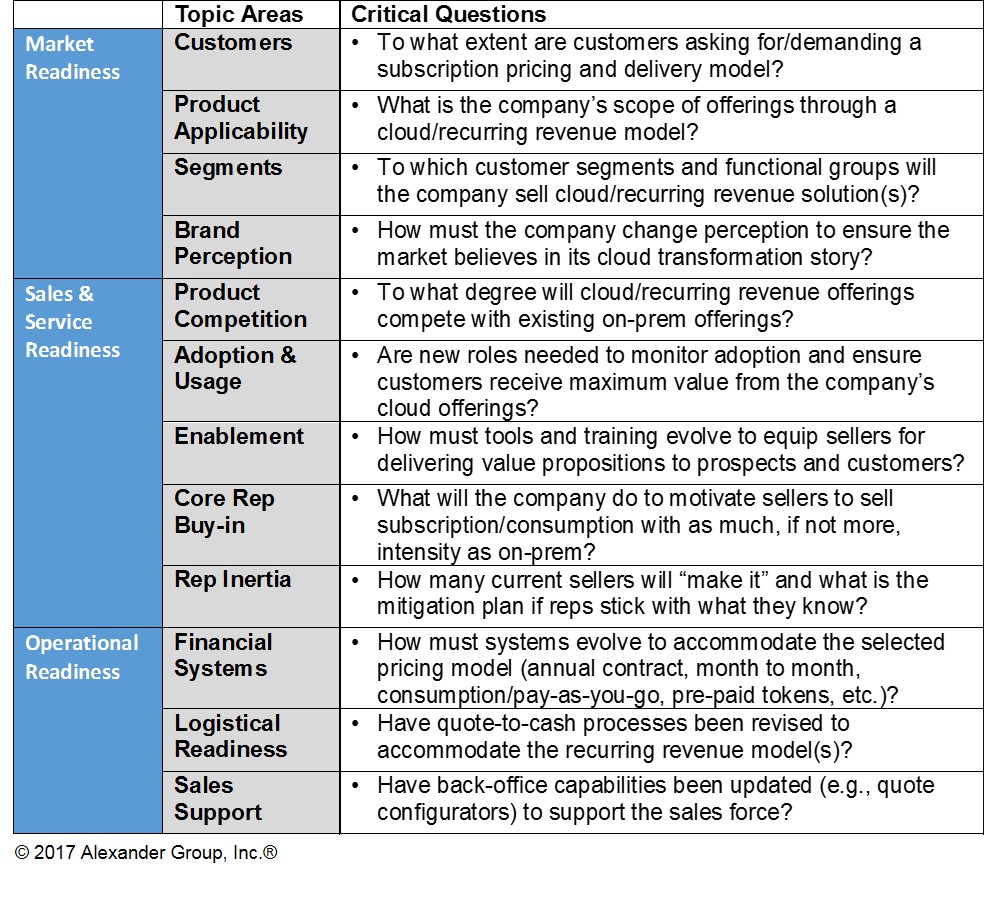Building a Blueprint for Sustainable XaaS Growth

Recent entries in this series described the cross-sell/upsell imperative, established a cloud readiness framework and explained the criticality of customer lifetime value. Below is the latest installment focusing on building company “muscle” capable of transitioning to a successful XaaS sales model.
Pundits have varying forms of saying the same thing: transition to the cloud or die. Management at most legacy on-prem companies have heeded this dire warning. Tech executives increasingly communicate and reinforce the XaaS transition imperative to markets, customers and employees. Yet change is slow despite positive outward projections because decisive action is lacking. The call to action is clear. The blueprint is not.
A successful XaaS transformation blueprint is predicated on answering tough questions. The framework below, while not fully exhaustive, paints a clearer picture of what various functional groups must address prior to launching and scaling XaaS offerings.
 Market Readiness: Legacy on-prem companies start at a disadvantage relative to their pure-play counterparts. Customers are accustomed to buying products a certain way. Company brand is based on a dated technology delivery model. Executives must grapple with changing customer behavior and company perception while also achieving short-term financial goals and guarding their flanks from up-and-coming pure-plays.
Market Readiness: Legacy on-prem companies start at a disadvantage relative to their pure-play counterparts. Customers are accustomed to buying products a certain way. Company brand is based on a dated technology delivery model. Executives must grapple with changing customer behavior and company perception while also achieving short-term financial goals and guarding their flanks from up-and-coming pure-plays.
Blueprint Imperative: Think carefully about which offerings (new or existing) will operate within a cloud model and into which segments the company will sell those offerings. The switch to cloud does not occur overnight. A phased approach is best. Start with the customer segment(s) most eager and willing to buy and consume cloud-based offerings. Then determine which offering(s) the company is most capable of delivering over the cloud in the near future.
Sales & Service Readiness: Sales people don’t like change. They sell what they know. Selling in a cloud world requires a complete mindset shift as buyers and value propositions have evolved. Additionally, the gap between company revenue (historically ship date or equivalent) and representatives’ commissions has widened because revenue takes longer to recognize within a cloud model. This much is certain: some sellers will continue operating with an old world mindset or simply won’t buy in to the company’s go-forward vision.
Blueprint Imperative: Be realistic about who within the sales force will successfully make the cloud transition using two dimensions–skill and willingness. Participants at Alexander Group leadership summits consistently reference that 50+ percent of their legacy sales force won’t make it in the new world. How many will make it in your company?
Operational Readiness: Assume for a moment that your sales force is primed and ready to sell the company’s new cloud solutions. Worst-case scenario is to have a highly qualified deal but fail to close and deliver. Surprisingly, the Alexander Group regularly encounters fundamental back-office gaps during the cloud transition period. Examples include an inability to invoice monthly, unmodified pricing configuration tools and outdated proposal templates. Sellers, customers and markets will quickly lose faith in the company’s ability to deliver cloud solutions if sales leadership does not address “behind the scenes” logistic requirements with the same rigor and investment devoted to customer-facing changes.
Blueprint Imperative: Spend ample time redesigning the entire quote-to-cash process. Contemplate what could go wrong with customer experience if systems, tools, etc. aren’t augmented to operate in the new cloud model. Make the investment today to avoid poor customer experience (and high churn) in the future.
AGI has services to design and build out your company’s new XaaS operational model. Learn more about the Alexander Group’s Technology practice or contact a technology sales expert to discuss your company’s XaaS needs.